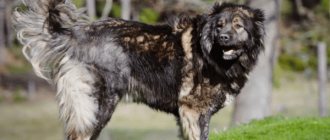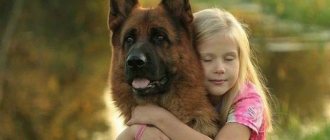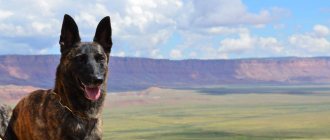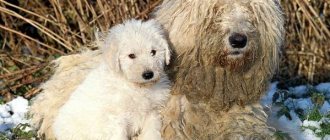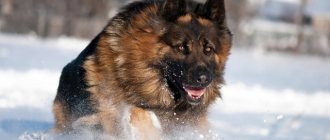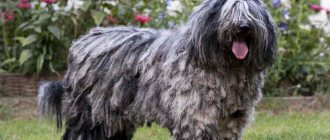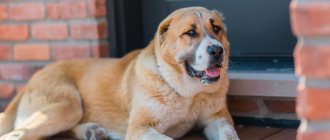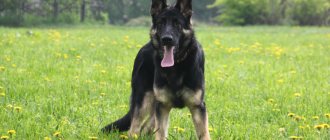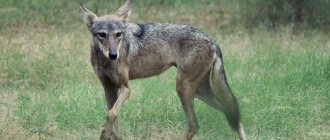Dear future dog owners!
If you decide to buy a maremma, then before purchasing a puppy, ask yourself the question: are you ready to spend a large amount of your time on training and socializing the dog until it reaches the age of one year, and then regularly maintain the acquired skills?
Remember, for a dog to behave adequately, its head should ALWAYS be occupied with daily activities, of course, without “overload”, in a playful way.
It is important for every owner to know that Maremmas are dogs that are very different from other dog breeds. Many people are mistaken in believing that if the name of the breed contains the word “shepherd”, then the Maremma should be raised in the same way as other shepherds. Unfortunately, today many trainers who have no experience working with Maremma and do not know the characteristics of this breed begin to train the dog incorrectly, and as a result, they get a completely different result than they expected. One of the instructors said about the Maremma that their problem is that they are thinking dogs. I wonder whose problem it is, the dog’s or the instructor’s?)))
The ancestors of the Maremma were wolfhounds, so the most ancient purpose of this dog was to protect flocks of sheep in pastures, acting as the main assistant to the shepherd. Often the white dog had to be left alone with the flock and make any decisions on its own, this influenced the formation of the freedom-loving and independent character of the Maremma.
Remember that love and understanding are important in raising a Maremma. The dog should not be physically punished. This will lead to a loss of your authority in the eyes of your pet, which will then be extremely difficult to restore. If your friend has done something wrong, punish him with your voice, but do not use physical violence. You can reason with a teenager or an adult shepherd by pressing him to the ground by the withers and growling menacingly in his ear, showing that you are in charge. From the very first minutes of communication with a puppy, he must understand that you are the leader of the pack, and it will always be so. You make absolutely all decisions, not the dog. The dog follows your commands: when to start eating, when to jump out of the trunk of a car, to leave the enclosure with the door already open, etc. You should be the first to enter somewhere, not the dog. The dog should not come closer than two meters to the dinner table (if you let the dog into the house or at a picnic), because the leader is at the table! Everything is like in a pack of animals. And remember, the dog perceives your pity as your weakness, and your authority as a leader in its eyes decreases, as a result, the pet’s obedience becomes worse.
Don't pay attention to people who claim that a maremma should only know two basic commands - “sit” and “come”. This is wrong! A dog can quite easily and quickly master the entire course of general training. If you start training your pet from an early age, then already at four to five months your puppy will be able to understand and carry out all the basic commands (“come to me”, “lie down”, “sit”, “place”, etc.). In training, the main thing is to be able to interest the dog, which is much easier to do with a puppy, then every dog walk and training will bring you both a lot of positive emotions.
Despite all this, 8-9 month old puppies can also quickly achieve good training results. It is important for a breeder to choose the right approach to training their pet. Before purchasing a grown-up puppy, ask its owner whether the dog has been socialized and whether it walks on a leash. If this is not the case, then it will be possible to achieve something from the maremma, but it will be much more difficult.
Treat your dog with respect! And always remember that all the gaps in your pet’s upbringing are your shortcomings!
The initial training of the Maremmo-Abruzzese Shepherd Dog is no different from the training of dogs of other breeds. Puppies remember everything very quickly and are easy to train. However, as your dog matures, he begins to question your commands. And here you should not show your weakness, otherwise the pet will simply “sit on your neck.”
To summarize all of the above, it is worth emphasizing that the process of training and raising a dog is continuous and lasts its entire life.
How much does a puppy cost?
The puppy moves to a new home at the age of 1.5 - 2 months; it is worth choosing a breeder in advance. Each nursery has a website where they announce matings and have information about the parents.
Choosing a puppy is not difficult, first get to know the breeder, see the baby’s mother, ask about her health, look at the pedigree.
Babies at this age are active and inquisitive, eat and sleep a lot. They look like plush little polar bears.
The cost is quite high: from 800 to 1300 euros. Puppies with good exterior characteristics and a future for exhibition stand accordingly higher than their fellow breeders.
Who should train a maremma?
Many people believe that it is better to entrust the upbringing and training of the Maremma to specialists working in so-called training schools. However, dog owners forget that the Maremma will only obey the one he considers the leader, namely the one who trains him. It is important to know that the dog includes in the conditioned reflex not only the sound of the command, but also the appearance, as well as the voice of the person who gives this command. As a result, it turns out that a specially trained person “makes the dog his own,” and when it gets back to its owner, it completely refuses to follow any commands and does not obey well.
To avoid this, it is better to train your pet under the guidance of an experienced instructor. This means that the trainer must be the owner of the dog, and the instructor, in turn, must teach the owner all the intricacies of raising the animal and manage the training process indirectly. The best option is to seek help from an experienced instructor who works with Maremmo-Abruzzese Shepherd Dogs and work with him 1-2 times a week, conscientiously completing homework.
Basic training should be devoted to 10-15 minutes twice a day. You should not bore your puppy by forcing him to perform the same commands a hundred times. Otherwise, the dog will associate training with coercion and negative emotions, and therefore the entire learning process will be less productive. Always reward your pet for following commands correctly. You can do this with a piece of cheese, cookies or other tasty treats. At the initial stage, the treat must be given every time a command is completed, then simply praise and a pat on the head will be enough.
"Golden rules" of training:
- Give commands loudly and clearly, but do not shout. You can only change the intonation, but not the command itself;
- Praise your dog sincerely and emotionally. The ideal reward is when the dog wags its tail in response to your actions and words;
- Not a single command of yours should remain unfulfilled;
- Always indicate the end of a command by issuing another command or going into a free state (for example, “walk”).
History of the origin of the species
There is no exact information about the origin of the breed. There is an assumption that it takes its roots from dogs that herded herds on the Pyrenees hills. The shepherd acquired its modern appearance in the 19th century. The ancestors of the beast were obtained as a result of natural crossing of dogs that worked on the distillation of sheep flocks from the Italian provinces of Abruzzo and Maremma. Both areas have long claimed ownership of the species. As a result of the debate, it was decided to combine the names of the regions in the name of the breed.
Maremma in Spanish pastures
Interesting ! For a long time, two Italian provinces – Abruzzo and Maremma – fought for the right to be called the homeland of the shepherd dog.
The White Italian Shepherd was recognized by the International Canine Association only in 1958.
The "sit" command
To give a command, you need to bend your arm at the elbow at a right angle, open your palm and raise it vertically. When practicing a command, it is better to use a treat as a reward. Take the treat in your right hand, show it to the dog, say the command “sit”, then raise your hand with the treat above the maremma’s head. This will cause the puppy to raise his head and sit down at the same time. As soon as the command is completed, give the baby a treat.
You can teach your dog this command by pressing the pet’s sacrum, but your four-legged friend must be on a leash. Take the leash with your left hand at a distance of 10-15 cm from the collar. After this, you need to say the command “sit”, pushing the dog back with your right hand and pressing on its sacrum with your left. When your dog sits, reward him with a treat without removing your hand from his sacrum. If the pet wants to get up, say “sit” again, accompanying your words by pressing on the dog’s sacrum.
When the maremma masters a simple command after several lessons, you can move on to complicating the task. Gradually, you need to teach the dog to remain in a sitting position for up to one minute. If the animal wants to change its position at this time, the trainer must immediately repeat the “sit” command. If everything is done correctly, reward your friend with a treat.
Brief historical background
The first written mentions of these shepherd dogs, dating back to the 1st century BC, are found in the works of the ancient Roman writers Varro and Columella, who describe snow-white Italian shepherd dogs guarding flocks of sheep and goats . It is not possible to accurately establish the family tree due to the remoteness of the events, but it is believed that these animals were brought to the European continent by Asian nomadic peoples. Among the ancestors of the Maremma are mastiff dogs, Tibetan wolfhounds and steppe mastiffs. The appearance of the Abruzzese Shepherd Dogs has remained virtually unchanged since then.
Initially, there were two varieties of white shepherd dogs, visually different and living in different regions of Italy (Tuscan Moremma, Lazio and Abruzzo). However, as a result of seasonal distillation of cattle, natural crossing occurred, the breeds mixed, forming one - the Maremma-Abruzzese. Since each of the regions claimed that shepherd dogs first appeared on their territory, and the parties could not reach an agreement, the breed received a double name - as a compromise.
Maremma - a shepherd dog that guards sheep
In 1898, the first individuals of the Maremma-Abruzzese Sheepdog were included in the studbook of the Italian Kennel Club; the first breed standard was developed in 1924 (two types of dogs were considered there). In January 1956, the standard characteristics were finalized, combining both species under the general name Maremmano-Abruzzese Sheepdog. In the same year, the breed was recognized by the world community. In the FCI register it is listed in group 1 - herding and cattle dogs (section 1 - shepherd dogs) under number 201.
The latest valid and current breed standard dates back to September 15, 1992.
Command "lie down"
To give a command, you need to raise your right hand forward, palm down, to shoulder level and quickly lower it down.
Plant the maremma, stand facing it, say the word “lie down”. It is better to take the treat in your right hand, bring it to the dog’s nose, smoothly lowering it down to the paws. When your dog tries to reach for the treat, move your hand closer to you. This will make the animal lie down, after which reward your tailed friend with a tasty treat.
When the first basics of the command have been mastered, the dog must be taught to maintain a lying position for 1-2 minutes. To do this, the trainer must put the dog down, repeat the “lie down” command again and move 1-2 steps forward from the animal. If the animal tries to get up, the command “down” must be given again.
Training
Herding dogs have high intelligence and grasp everything new very quickly. Therefore, you need to start training a puppy as early as possible - this reduces the chance of aggression towards the owner during character formation.
The period from 6 months to two years is considered dangerous. At this time, you need to be especially careful when communicating with the dog, since the owner will have to constantly demonstrate his superiority. Only in this case will it be possible to achieve submission. Any manifestations of “dissatisfaction” with the owner’s decision must be immediately and harshly suppressed. The most effective way to demonstrate a person's strength is to lift him by the scruff of the neck, then press him to the ground and hold him until the dog stops resisting.
Command "stand"
This command is given in this way: the trainer swings his right arm, slightly bent at the elbow, palm up, from the hip forward to waist level, then lowers the hand down to the thigh of the right leg.
The command must be practiced from a sitting or lying position of the dog. The trainer must stand facing the dog, take a treat in his right hand, say the command “stand” and bring the treat to the animal’s nose. The hand needs to be smoothly moved up and towards you. When your dog gets up, reward him with a treat.
You can practice this command on a leash. To do this, you need to sit or lay the dog down, take a step forward and pull the pet forward or up by the leash. If the command is given to a dog that is in a lying position, then at the same time as giving the command, push the animal under the stomach to force it to rise.
To learn how to control a puppy from a distance, it is better to choose a quiet and deserted place where the dog will not be distracted by noises or passers-by. Give your four-legged baby a little walk. Put a long leash on the puppy, and when the baby pulls it, command “stand” and pull the leash towards you. Be demanding of your animal and make him stop for at least a couple of seconds. Reward your dog with something tasty for obedience and following your command. Remember that if all actions during training are accompanied by rewards (both food and affection), the dog will quickly learn the command.
Be sure to teach your dog the “stay” command. This must be done so that you can control the animal from a distance when its movements are not limited by a leash. A dog that is not trained in this command during a walk can run after a cat or another dog and, while crossing the road, get hit by a car or cause an accident. Therefore, before you let your pet off the leash, you must know for sure that the animal will clearly follow the “stand” command.
If you are crossing the road with a dog, lead your friend by the collar or on a short leash. Remember that any, even the most intelligent and trained dog, may want to cross the road on its own and, as a result, get hit by a car.
When approaching the road, call your dog and hold it firmly on the leash. You need to stand for a while in front of the road, giving the animal the command to “stand” and pulling on the leash. After several such trainings, the dog will remember all the actions and will independently approach you near the road and stick to your left leg.
What does an Italian Shepherd look like?
Externally, the Maremma dog gives the impression of a powerful, large and tall dog. Her movements are light and her temperament is lively. Even with its impressive size and powerful build, the dog can simply climb a steep mountain. Thick white fur gives the pet volume. The Maremma has a large head, powerful jaws, and small drooping ears. Despite its heaviness, the animal remains mobile and flexible. Overall, this is a dog of impressive appearance and majestic demeanor.
Appearance and description
Even with its size, the dog is not particularly large. Males reach about 75 cm in height, and females are slightly smaller - up to 70 cm. The large head and roughly built body give the impression of a polar bear, but this does not prevent the animal from looking noble and majestic. The body weight of females reaches 31-42 cm, and that of males – 46 kg. With such a weight, the hardy dog remains maneuverable.
Features of the coat
The breed is distinguished by its snow-white coat color, but you should not be afraid of this. Each hair has a special coating with a wax-like lubricant. It also prevents dirt from being absorbed. For this reason, dirt, wet soil and sand dry out and are then shaken off. The snow-white color is also characteristic of the Pyrenees Mountain Dog and the Hungarian Kuvasz. Other features of the coat of the Maremma-Abruzzese Sheepdog:
- thanks to the special structure of the coat, the animal feels comfortable at temperatures from -40 to +40 degrees;
- the main color is bright white, but variability with yellowish, creamy shades is allowed;
- The animal sheds only once a year;
- the coat is dense, hard, thick, straight, but in some places there are wavy areas;
- a kind of mane forms on the neck;
- hair is translucent;
- the length of the fur on the back reaches about 8 cm;
- the undercoat is thick (abundant only in winter);
- ribbed wool is a serious fault.
Movement "nearby"
It is very important to teach the dog to move next to the trainer (holding on his left leg) both on a leash and without it. The position of the animal is considered correct if its shoulder is at the level of the owner’s knee. The four-legged friend must be able to make turns on the spot and while moving, stay next to the trainer when changing the pace of walking, and sit independently near his legs when stopping.
Place the dog parallel to your left leg. Hold the leash with your right hand, and only lightly support it with your left. Command “near” and begin moving at a moderately fast pace. Further, when changing direction, speed of movement or during a stop, always give the puppy the “near” command. At first the dog will be 2-3 steps ahead of you, and this is normal. When the animal pulls forward, repeat the command again and make a sharp jerk with the leash, thereby returning your furry friend to your leg.
It is important to remember that you must first give the command and only then jerk the leash. After these actions, the animal will walk several steps next to you, holding on to your left leg. Praise your pet for this, but do not give him a treat on the go. Don't despair if after a few lessons your pet still doesn't learn this command. The only correct solution in this situation is to simply systematically repeat the command “near” and jerk the leash whenever the animal gets ahead of you.
After the jerk, release the leash so that it hangs freely. Let the puppy understand that he will feel good near your left leg, and for disobedience he will feel an unpleasant tug. After walking in a straight line, make several turns left and right. Before turning, command the dog “near.” If she lags behind, pulls ahead, or makes an unclear turn, then make a sharp jerk with the leash. Walk like this for a few minutes, then command “here,” sit the dog down, praise it and give it a treat. Then start all over again.
In the following lessons, teach your pet to make turns in a circle over the left shoulder, while periodically changing the speed of movement.
If the dog's training process is set up correctly, then after just a few lessons you will have to do much less jerking with the leash. If the animal has already learned to clearly follow the “near” command, then you can let the leash fall to the ground. Don't let your dog out of your sight. If she wants to get ahead of you or move to the side, step on the leash with your foot, command “near” and make a sharp jerk. If the pet still walks well with the leash off, then start training the dog without a leash.
In order to teach your puppy to turn, give him the command “near”, turn around yourself and with a jerk of the leash, turn your four-legged friend behind you. When the baby is at your foot, sit him parallel to your foot and carefully monitor the correct position of the animal. Often dogs take the wrong position, sitting at an angle and facing the owner. You must always correct your pet, otherwise the incorrect position will become permanent.
Distinctive features
Maremmas are recognizable by their distinctive features:
- The head is large, large, flat, similar to a bear.
- The forehead is low.
- The ears are large, hanging to the level of the cheekbones, set wide, pointed at the ends; cupping is rarely practiced.
- The stop is clearly pronounced, obtuse.
- The muzzle is narrow, bear-like; The nose is black.
- The eyes are dark, black, almond-shaped; eyelids black.
- The lips are dense and small.
- The teeth are strong and powerful; bite .
- Black leather
- The body is powerful, the muscles are distinct.
- The back is wide, muscular, straight.
- The chest is strong, developed, wide.
- The thighs are strong, with obvious muscles, and sculpted.
- Limbs straight, strong, elegant; The paws are massive and round in shape.
- The color is white, minor light tones are acceptable (fawn, red, beige).
- The hair on the head is of medium length, no more than 5 cm; The coat of the body is thick, with dense undercoat, 9-10 cm.
- The tail is covered with thick hair and is set low; When moving or having a strong emotional reaction, it rises slightly.
Command "come to me"
To give a command, raise your hand to the side at shoulder level, and then lower it to your hip (without clapping). Remember that this technique is the most important in dog training! The animal must always obey its owner and approach him from a standing or free position as soon as he hears the command “come to me.”
Start teaching this command not only during training and walking. As soon as the puppy arrives at your home, say “come” to him when you want to feed him or cuddle him. When the baby comes to you, give him food and stroke him affectionately. When going out for a walk, do not forget to take with you a treat that can attract the animal’s attention. Periodically give the command “come to me”, and when the puppy runs up to you, treat him with something tasty.
To practice the skill, put your dog on a long leash and give the command “walk.” Let the animal walk the full length of the leash. Then give the command “come to me” and begin with sharp jerks of the leash to force the puppy to come closer to you. The dog will quickly understand what the owner wants from it and will happily approach it.
Hearing the command “come to me,” the dog should run up to the owner and sit near his left leg. There are two main ways to teach an animal to do this.
- If your pet is on a leash, then simply lead him around you with the leash, transferring the leash behind your back from your right hand to your left. When the dog approaches your left leg, sit it down, pet it and reward it with a treat. At the same time, it is important to praise the puppy, saying “okay, come to me.”
- If the puppy was walking and off a leash at the moment the command was given, then lead the dog around you, enticing him with a treat.
You should not call a puppy who is too excited with the command “come to me”. Try to attract your baby's attention with a treat or pretend that you are running away. Most likely, he will run after you.
Character of the breed
The Maremma-Abruzzese Shepherd Dog has a very complex and unique character, which has been developed over centuries of independent work as a guard and shepherd . A self-sufficient and independent dog does not obey anyone; it accepts only partnerships. She does not recognize unconfirmed power and dominance, guided only by her own instincts. Only an authoritative owner can truly respect.
The entire being of the maremma is imprisoned under the protection of the owner's property and livestock. But it does not guard thoughtlessly; the animal is able to assess the situation itself and make its own decision, without waiting for a command from the owner. Possessing a strong sense of territoriality, the shepherd dog vigilantly controls the boundaries of the area entrusted to it, trying to keep as large an area as possible in its field of vision. The pet does not lose vigilance for a minute, being ready at any moment to overtake and repel the enemy.
Maremma always watches everything vigilantly
These snow-white shepherds are affectionate and gentle with members of their family; they are not only magnificent protectors, but also the most devoted, reliable friends. They are extremely wary of strangers, constantly monitoring their actions and movements. But they never show open aggression without a compelling reason. A smart dog is able to correctly assess the current situation and adhere to a certain line of behavior.
At night, Abruzzese Shepherds are especially vigilant. If during the day guests are allowed to move freely around the host’s property, then at night it is better to refrain from walking in the moonlight, because it is completely unsafe.
Maremma is infinitely patient and kind with her master's children, allowing her to do almost anything with her. A calm and balanced dog cannot be disturbed from its state of balance. However, such tolerance does not extend to the neighbor's brats, who extremely irritate the sensitive animal with noise and stupid running around. The dog gets along well with other pets and does not even conflict with cats. But on the street, large males can fight in the fight for a female.
Maremma is very loyal to children
There have been many cases of causeless aggression on the part of representatives of this breed towards people. In most cases, this manifests itself in an attack on their food, which the Maremma treats with extreme reverence.
Common mistakes in training:
- Punishment of a dog that approaches the trainer on the command “come to me.” This is a very serious mistake that owners often make if the dog has done something wrong. For example, she can pick up some food from the ground and eat it. The owner calls the pet using a command and punishes it. Don't forget that dogs have a very short memory. The animal will think that it is being punished for approaching its owner, and not for its previous offense. Therefore, if next time you give the command “come to me,” the dog will run away from you, as it will associate this command with punishment. The animal should always be rewarded with affection and treats for every approach, regardless of your mood. Remember that you need to punish only at the moment the offense is committed, but not some time after that!
- Calling once during the entire walk (before going home) is also a fairly common mistake, which leads to the dog beginning to associate the command “come” with close captivity on a leash. That is why it is worth giving your pet this command several times during a walk, each time rewarding him with a treat for following through and letting him go for another walk. This way the dog will not be afraid that after approaching you, it will be immediately put on a leash and taken home.
- Attempts to catch up with the dog if it refuses to voluntarily approach the owner. This can only make the situation worse. The animal will perceive your attempts to catch up with it either as fun or as a threat, so it will definitely not voluntarily approach you. In this situation, it would be more correct to attract the pet’s attention by pretending that you are running away or looking for something in the grass. A curious animal will immediately run up to you, however, do not immediately attach a leash to it - treat it with a treat and give the command “walk” (otherwise, you will never be able to interest your pet in this way again). After a few minutes, try repeating the “come to me” command.
- Attempts to call the dog when it is playing too much or is passionate about something. You should not give the command “come to me” if you know in advance that she will refuse to carry it out. The animal may be very keen on playing with its favorite toy or friend. In this case, find a way to distract the dog and only then call him to you. It is important that your four-legged friend does not show disobedience regarding the execution of this command.
Interaction with children
Some experts do not recommend keeping maremmas as pets if there are small children in the family, as they consider these animals to be unpredictable and aggressive.
Maremma puppies are very playful, which children love.
But most owners of Italian shepherds assure that dogs of this breed are very kind and gentle towards children. You can’t call a Maremma playful, but the dog will patiently endure all the baby’s tricks, allowing him to “treat” himself while playing doctor or tying a bow on his head if the child imagines himself to be a hairdresser.
The owner can safely leave the baby under the supervision of such a guard. After all, the dog will not only not allow a stranger to approach him, but will also stop any attempts by the child to leave the territory.
To be fair, it is worth noting that the friendliness and patience of maremmas only applies to the owner’s children. The shepherd may perceive the neighbor's children as a potential threat. And some dogs are irritated by noisy games and running around of children, so it is not advisable to involve your pet in active and fun games.
Team "teeth"
You must teach your dog to respond calmly and indifferently to the dental examination procedure. This will be necessary not only for displaying the animal at exhibitions, but also for treating possible diseases of its teeth.
To show your dog's bite, give him the "sit" command and turn slightly towards him. Take the dog's face so that your left hand is on the upper jaw and your right palm is under the lower jaw. Lightly squeeze your dog's mouth until the teeth are tightly closed. Using the thumb and index finger of your left hand, lightly lift the animal's upper lip, and with your right thumb, slightly pull down the lower lip. The nose should be open and located between the thumb and index finger of the left hand.
Do this procedure with your dog more often, and the animal will quickly get used to it. First, teach the dog to calmly respond to cupping his muzzle with your palms. To do this, leave your hands on the dog's face for only 3-4 seconds, then treat your pet with a treat. Gradually, the girth time should be increased to 8-10 seconds. Do not cause pain or negative emotions to the puppy during the dental examination, otherwise in the future the animal will simply resist and be afraid of this procedure.
Interesting Facts
There are several facts associated with the Maremmo-Abruzzese dog that are worthy of attention. One of them is sad.
- Having crossed the threshold of approximately 11 years, considering that the life limit has come, dogs stop eating, then stop drinking. They end up dying. Being healthy, animals pass away. Owners and veterinarians are having trouble bringing Maremma Sheepdogs out of voluntary decline.
- The first known depiction of a white shepherd dog dates back to the Middle Ages. In the city of Amatrice, in the Church of St. Francis, a 14th-century fresco depicts a white dog in a spiked collar guarding sheep. The dog in the mural looks the same as the modern maremma in the photo .
- In the 1930s, the British exported several herding dogs from Italy. At this time, there were disputes between animal connoisseurs about which province made a decisive contribution to the formation of the breed. The British were not imbued with the small-town concerns of the Italian dog handlers and called the dog Maremma. Later, the breed received a longer and more precise name: Maremmo-Abruzzese Shepherd Dog.
- In the last century, in the 70s, sheep farmers in the United States had a problem: meadow wolves (coyotes) began to cause noticeable damage to sheep herds. Environmental laws limited how predators could be controlled. Adequate countermeasures were required. They were found in the form of herding dogs.
- 5 breeds were brought to the States. In competitive work, Maremmas have proven that they are the best shepherds. In sheep herds guarded by Italian Shepherds, losses were minimal or non-existent.
- In 2006, an interesting project began in Australia. The population of one of the species of aboriginal penguins has approached the numerical limit beyond which an irreversible process of extinction begins.
- The government has recruited Maremma herding dogs to protect birds from foxes and other small predators. They were considered the reason for the decline in bird numbers. The experiment was successful. Now maremmas guard not only sheep, but also penguins.
Command “no” (“fu”, “no”)
The “fu” command is given to a dog when, for example, it picks up something from the ground. Here it is very important to let the dog understand that you always have something tastier than on earth. Provoke the dog: scatter treats on the ground, take the puppy on a leash and start moving past the treats, while very carefully controlling the situation - the dog should not have time to grab a piece from the ground. At this moment, your assistant should call the puppy to you, switching it to you. Be sure to reward the dog for passing by the treat. This way you will reinforce in her the skill that you ALWAYS have something more interesting and tasty than on earth. The task must be made more difficult by gradually training in the most attractive situations for the puppy. Execution of this command and the absence of the habit and even the thought that you can take something from the ground into your mouth are directly related to the health of your pet!
Teach your baby not to take food from the hands of strangers. Ask your friends to hand food to the puppy in the palm of their hand. Give the command "fu". Maremmas already do not trust strangers, so it is unlikely that she will take food. Be sure to reward your pet for this.
Diseases and life expectancy
Since humans did not interfere with the development of this breed, the Abruzzese Shepherd Dog has good health, developed under conditions of natural selection of the strongest individuals.
If you feed your dog improperly, it may have stomach and skin problems. Due to increased physical activity, the puppy is at risk of developing joint diseases. You need to know that during the growth period, dogs need food with a high calcium content to form and strengthen bones.
You should know! The lifespan of maremmas, like all large dogs, is not long - up to 12 years.
Keeping your pet in an enclosure in winter will not harm your pet.

